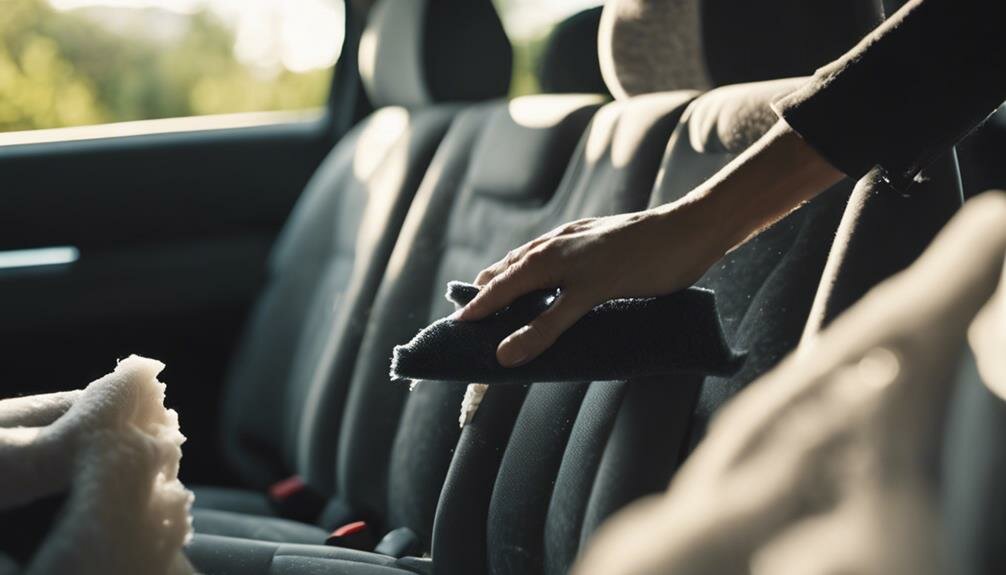Gather Your Supplies:
You'll need gloves, an upholstery-friendly cleaning solution, soft-bristled brushes, microfiber cloths, and a vacuum cleaner.
Identify the Stain Type:
- Food stains: use enzyme cleaners
- Grease: apply a degreaser
- Ink: rubbing alcohol works well
Pre-Treat the Stain:
- Test the cleaner on a hidden spot
- Blot gently with a damp cloth
Use Homemade Solutions:
- Baking soda paste for general stains
- Vinegar and dish soap mix for deodorizing
Neutralize Odors:
- Ventilate the car, use enzymatic cleaners, or baking soda
Continue and discover more efficient techniques and preventative measures.
Gather Your Supplies

Before tackling stains and odors in your car upholstery, you'll need to gather a few essential supplies. Proper preparation will guarantee you have everything you need for an effective cleaning process. First, make sure you have gloves for protection. Wearing gloves will shield your hands from harsh chemicals and any grime you may encounter.
Essential Supplies:
- Gloves: For hand protection.
- Cleaning Solution: Choose a cleaner suitable for your upholstery type.
- Brushes: Soft-bristled brushes for gentle scrubbing.
- Microfiber Cloths: For wiping and drying surfaces.
- Vacuum Cleaner: To remove loose dirt and debris.
- Spray Bottle: To apply the cleaning solution evenly.
Workspace Preparation:
Next, set up your workspace. Park your car in a well-ventilated area, preferably outside or in a spacious garage. Adequate ventilation is essential when using cleaning products, as it helps to disperse fumes and speeds up drying time. Lay down old towels or a plastic sheet to protect the surrounding areas and catch any drips or spills.
Identify the Stain Type
To effectively clean your car's upholstery, you first need to identify the type of stain you're dealing with. Common stain categories include food spills, ink, grease, and pet accidents, each requiring different cleaning methods. Once you determine the stain type, you can use the appropriate stain-specific cleaning techniques to achieve the best results.
Common Stain Categories
Common Stain Categories
Understanding the type of stain on your car upholstery is essential for choosing the right cleaning method. Stains can be categorized into several types, each requiring a specific approach for effective removal. Here are some common stain categories you might encounter:
Food Stains
Food stains are among the most frequent issues. They can range from greasy fast food to sticky candy. These stains often leave behind both visible marks and odors. Identifying the food source helps you choose the correct cleaning product.
Drink Spills
Drink spills, like coffee, soda, or juice, can quickly seep into upholstery fibers. These spills not only stain but also may leave lingering smells. Knowing whether the spill is sugar-based or acidic helps in determining the best cleaning method.
Ink and Dye Stains
Ink from pens or dye from clothing can transfer onto your car seats. These stains can be particularly stubborn and may require specialized cleaning solutions.
Biological Stains
Biological stains, such as blood or vomit, pose additional challenges due to the proteins they contain. These stains can also be a source of unpleasant odors, making prompt action essential.
Oil and Grease Stains
Oil and grease stains often result from food or mechanical work. These stains can be tough to remove and usually require a degreasing agent.
Stain-Specific Cleaning Methods
Identifying the stain type on your car upholstery is essential for selecting the most effective cleaning method. Different stains require different approaches, and using the wrong cleaner can make the stain worse. Here's how you can tackle specific stains:
Food and Beverage Stains
- Common stains: Coffee, soda, ketchup
- Cleaning method: Use enzyme cleaners, which break down organic compounds. Apply the cleaner, let it sit for a few minutes, then blot with a clean cloth.
Grease and Oil Stains
- Common stains: Motor oil, butter, makeup
- Cleaning method: Use a degreaser. Apply it to the stain, scrub gently with a brush, and wipe away with a cloth.
Ink and Dye Stains
- Common stains: Pen ink, fabric dye
- Cleaning method: Use rubbing alcohol. Dab a small amount onto a cloth and blot the stain gently.
Biological Stains
- Common stains: Blood, vomit, urine
- Cleaning method: Enzyme cleaners are effective. Apply, let it sit, and then blot. For persistent odors, consider using stain protectants after cleaning to prevent future issues.
Pre-Treat the Stain

Before you can treat the stain, you'll need to identify its type to choose the right cleaner. Once you have the proper cleaner, always test it on a hidden spot of your car's upholstery to make sure it doesn't cause damage or discoloration. This step guarantees that the cleaner is safe to use on the visible areas of your car seats.
Identify the Stain Type
Understanding what caused the stain is essential for selecting the appropriate pre-treatment method and ensuring effective removal. Identifying the stain origins and stain characteristics will help you determine the best approach for tackling the problem.
Common Stain Types
- Food and Beverage Stains: These often result from spilled drinks or dropped food. They can vary widely in their specific composition, affecting how they should be treated.
- Mud and Dirt: These stains are usually straightforward but can become deeply embedded in the fabric, making them harder to remove.
- Oil and Grease: These stains are particularly stubborn due to their slippery nature and can require special treatment to break them down.
- Ink and Dye: Ink stains, such as those from pens or markers, can be challenging due to their strong pigmentation and tendency to spread.
Observing Stain Characteristics
- Color: The color of the stain can provide clues about its origin. For example, a red stain might be from a beverage like wine or juice.
- Texture: The texture can indicate whether the stain is oily, watery, or sticky, affecting how it will respond to different cleaning agents.
- Location: The location of the stain might give you hints about what caused it, such as food stains in the passenger seat or mud on the floor mats.
Choose Appropriate Cleaner
Selecting the right cleaner is crucial for effectively pre-treating the stain and guaranteeing it doesn't set into your car upholstery. Begin by identifying cleaner ingredients that are safe for the material of your seats. For fabric upholstery, look for cleaners with mild detergents and enzymes that break down organic stains. For leather or vinyl, opt for pH-balanced cleaners to avoid damaging the surface.
Product Recommendations
- Fabric Upholstery:
- Folex Instant Carpet Spot Remover: This is a popular choice for fabric due to its non-toxic, odor-free formula.
- Chemical Guys Fabric Clean: Known for its strong cleaning power and safe ingredients, it's ideal for tough stains.
- Leather Upholstery:
- Leather Honey Leather Cleaner: This pH-balanced cleaner is effective yet gentle on leather surfaces.
- Meguiar's Gold Class Leather Cleaner: It cleans and conditions, making it a good option for maintaining leather.
- Vinyl Upholstery:
- 303 Aerospace Protectant: This versatile cleaner works well on vinyl, offering UV protection too.
- Mother's VLR: Combining a cleaner and conditioner, it's perfect for vinyl and leather alike.
Choose a product appropriate for your upholstery type to pre-treat the stain effectively. This helps make sure the stain lifts easily without causing further damage or lingering odors.
Test on Hidden Spot
Test on Hidden Spot
To guarantee the cleaner won't damage your upholstery, test it on a hidden spot first. This step, often referred to as a patch test or spot testing, is essential for protecting your car's interior. Here's how to do it effectively:
Steps for Spot Testing:
- Select a Hidden Area:
Choose a part of the upholstery that isn't normally visible, such as under a seat or in a corner.
- Apply the Cleaner:
Put a small amount of the cleaner on a clean cloth or sponge. Gently dab it onto the selected hidden spot.
- Wait and Observe:
Allow the cleaner to sit for a few minutes, typically around 10-15 minutes. Check for any discoloration, fabric damage, or adverse reactions.
- Inspect Thoroughly:
After the wait time, gently blot the area with a clean, damp cloth to remove any remaining cleaner. Look closely to ensure there's no negative effect on the fabric.
Use Homemade Solutions
For a budget-friendly way to tackle stains and odors, try using homemade solutions that are both effective and easy to make. Using natural ingredients, you can create DIY recipes that are safe for your car and the environment. Here are some simple and effective methods:
Baking Soda and Water
- Ingredients: Baking soda, water
- Instructions: Mix equal parts baking soda and water to form a paste. Apply the paste to the stained area, gently scrub with a brush, and let it sit for 30 minutes. Wipe it off with a damp cloth.
Vinegar and Dish Soap
- Ingredients: White vinegar, dish soap, water
- Instructions: Combine one cup of white vinegar, a few drops of dish soap, and two cups of water in a spray bottle. Spray the solution on the stained area and scrub lightly with a brush. Blot with a clean cloth until the stain is gone.
Lemon Juice and Baking Soda
- Ingredients: Lemon juice, baking soda
- Instructions: Mix lemon juice with baking soda to form a paste. Apply to the stained area, scrub gently, and let it sit for 15 minutes. Wipe it clean with a damp cloth.
Commercial Cleaners

If homemade solutions aren't cutting it, you might consider using commercial cleaners designed specifically for car upholstery. These products are formulated to tackle tough stains and odors, often with greater efficiency than DIY methods.
Choosing the Right Product
When selecting a commercial cleaner, it's wise to read product reviews to understand how well it works for others. Look for products with high ratings and positive feedback, especially from users with similar upholstery materials. Consider factors like important, guarantee, best for your car's interior.
Application Tips
Using commercial cleaners correctly is important for achieving the best results. Here are some application tips:
- Test First: Always test the cleaner on a small, hidden area of the upholstery to ensure it doesn't cause discoloration or damage.
- Follow Instructions: Each product comes with specific instructions. Follow them closely for best results.
- Use Sparingly: Apply the cleaner sparingly to avoid soaking the fabric, which can lead to mold or mildew.
- Blot, Don't Rub: When working on stains, blot the area gently with a clean cloth instead of rubbing, which can spread the stain.
Neutralize Odors
Eliminating persistent odors from car upholstery requires targeted strategies that address the root cause of the smell. First, identify the odor sources. Common culprits include food spills, pet accidents, and cigarette smoke. Once identified, remove any physical remnants that might be causing the odor. For instance, vacuum the area thoroughly to eliminate any loose particles.
Next, employ ventilation strategies. Open all car doors and windows to allow fresh air to circulate. Doing this helps dissipate lingering smells and introduces clean air into the vehicle. If weather permits, leave the car open for an extended period.
To neutralize odors, consider natural deodorizers:
- Baking Soda: Sprinkle it on the upholstery, let it sit for several hours, then vacuum it up.
- White Vinegar: Mix equal parts water and vinegar in a spray bottle, lightly mist the upholstery, and let it dry.
- Activated Charcoal: Place small bags of activated charcoal in your car to absorb odors over time.
For stubborn smells, use an enzymatic cleaner specifically designed for organic odors. These cleaners break down the molecules causing the odor, effectively neutralizing them. Consistency is key, so repeat these steps as necessary to maintain a fresh-smelling car.
Deep Cleaning Techniques

Deep Cleaning Techniques
Once you've neutralized odors, it's time to tackle deep cleaning techniques to restore your car's upholstery to its original condition. Start by removing any loose debris using a vacuum cleaner with a brush attachment. This will make the deep cleaning process more effective.
Steam Cleaning
Steam cleaning is a highly effective method for deep cleaning upholstery. The high temperature of the steam helps to break down dirt and stains, making them easier to remove. Here's how you can do it:
- Prepare the Steam Cleaner: Fill the steam cleaner with water and allow it to heat up.
- Test on a Small Area: Test the steam cleaner on a small, inconspicuous area of the upholstery to make sure it doesn't cause any damage.
- Clean the Upholstery: Slowly move the steam cleaner over the upholstery, ensuring even coverage. Pay extra attention to stained areas.
Fabric Protection
After steam cleaning, applying fabric protection is essential to maintain the cleanliness of your upholstery. Fabric protection products create a barrier against future stains and spills. Follow these steps:
- Choose a Fabric Protector: Select a product designed specifically for car upholstery.
- Apply Evenly: Spray the fabric protector evenly over the cleaned upholstery.
- Allow to Dry: Let the fabric protection dry completely before using your car again.
Preventative Measures
Preventative Measures
To keep your car's upholstery looking fresh and clean, implementing preventative measures is key. Here are some effective steps you can take:
Seat Covers
- Protective Barrier: Seat covers act as a protective barrier, keeping spills, dirt, and grime away from the original upholstery. They're easy to remove and wash, making them a practical choice for maintaining cleanliness.
- Variety of Options: Available in various materials and designs, seat covers can match your car's interior while providing the necessary protection.
Regular Vacuuming
- Routine Maintenance: Regular vacuuming helps to remove dust, debris, and crumbs that accumulate over time. This prevents particles from embedding into the fabric, which can lead to stains and odors.
- Vacuum Attachments: Using the right attachments, such as a brush or crevice tool, ensures you reach all areas, including between seats and along seams.
Quick Responses
- Immediate Action: Address spills and stains immediately to prevent them from setting. Keep a small cleaning kit in your car, including a cloth, mild cleaner, and a brush.
- Spot-Test: Always perform a spot test on a small, inconspicuous area before using any new cleaning product to make sure it won't damage the upholstery.





